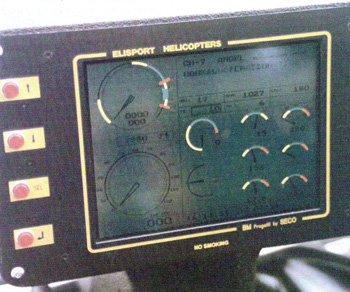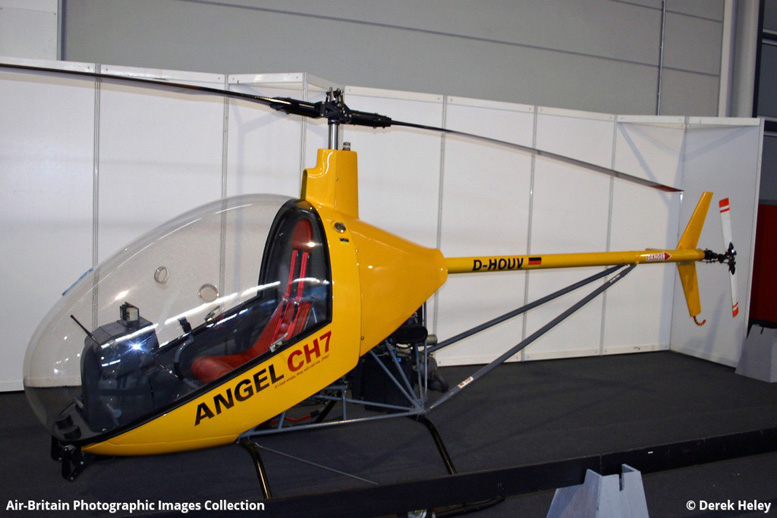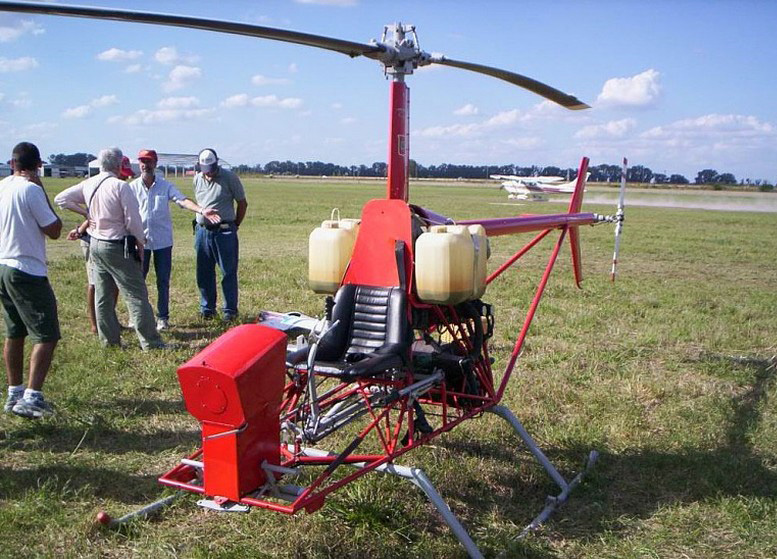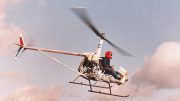Elisport Italia CH-7 Angel Kit Helicopter
CH-7 Angel helicopter Article Date: February 1994
Who says that the pioneering spirit in aviation is dead? When I flew the single-seat CH-7 Angel helicopter, I felt as if I were the first pilot ever to fly; that the sky was mine alone; that this was something new and sensational.
Those of you who were rather taken by the Revolution Mini 500 Rotax-powered single-seat kit helicopter will be aware that the design was inspired by Augusto Cicare’s homebuilt CH-6 – the cabinless version of the CH-7 Angel helicopter.
In fact, rather a lot of the Mini 500 promo video actually features the Cicare machine. A helicopter engineer for 35 years, Cicare has been one of the leading lights in the homebuilt helicopter movement, although not that well-known outside his field, because he works and lives in Argentina.

LEFT: The blades are lightweight composite and filled with lead weights in the leading edge.
RIGHT: 46 mph is recommended for approach and normal takeoff.
Failing to come to an agreement with Revolution’s Dennis Fetters, Cicare ended up in Europe and joined forces with Elisport, who markets microlights in Italy. Elisport got to work on the CH-6, and, after a variety of modifications and improvements, it became the CH-7.
EDITOR: It wasn’t too surprising that in the United States, the Mini 500 got huge media coverage looking much like the Vietnam era “Hughes 500 LOACH”. It was also significantly cheaper – not always a good sign of a design (with the exception of today’s Mosquito Kit Helicopter). The Mini-500 struggled with endless issues!
They then commissioned Marcello Gandini to style the CH-7. Who? Well, have you ever drooled over a Lamborghini Contach or Diablo? He was responsible for the looks. Anyway, although Cicare is no longer involved in the CH7 Angel, he still works with Elisport and is building a two-seat training model.

The Flight Manager Computer System is a microprocessor-controlled instrument panel, systems management, and data recorder, all rolled into one.
Not surprisingly, the specification and design of the Mini 500 and the CH-7 Angel helicopter is very similar-with a 4130 steel tube airframe, an alloy tube tail boom, and a 65 hp Rotax 582 engine providing the power.
The “fuselage” is a simple fiberglass fairing. The airframe is filled with an inert gas, and a pressure-gauge sits on the floor of the cockpit: this will give the first indication of any cracks in the airframe.
This is not a new idea: it is used in various aerobatic aircraft, such as the Lazer and several models of Zlin, but clearly it is an important safety factor for any aircraft. There is a bubble canopy of flexible plastic which changes shape in flight!
This is another safety factor, as it will not shatter (on impact with a bird, for instance). The only disadvantage is a slight distorted view of the ground as you come into land, but there was no false height sensation, only that of being inside a fish bowl.
I found the outlook more comical than dangerous. The blades are a lightweight composite filled with lead weights in the leading edge. This gives them controllability, strength, and high inertia. The rotor system is semi-rigid with a teetering head.
The manufacturers got rid of the swashplate and instead use a direct spider system, which they describe in their brochure as “humiliating all previous helicopter engineers” (Sikorsky, lie down and die!). Certainly it reduces the rotating parts of the main rotor which, as Robinson discovered earlier, makes for less engineering and cheaper costs.

The Angel’s cockpit is extremely well laid out and comfortable.
The engine is a two-stroke, water-cooled Rotax 582—the type usually utilized in ultralights although the CH-7 Angel helicopter has an extra cooling fan. It delivers 65 hp and has a dual-ignition system. In the cockpit, you have a strange mixture of highly modern and less sophisticated technology. The instrument panel is now a digital/analogue computer controlled module.
The “Flight I Manager Computer System”, or FMCS for short, is a microprocessor-controlled instrument panel, systems management, and data recorder, all rolled into one. It has (as of yet) no back-up system and so far they have never had a serious problem; however, they are considering this possibility.
Before you can start up the CH-7 Angel helicopter, you are required to enter the pilot’s weight and the current dewpoint. It will then warn you not to attempt any landings above a certain altitude, as well as alert you when induction icing conditions are possible or actual.
It will display the information you normally require in the format you want it (i.e., airspeed in mph, kt, or km/h) as well as highlight out-of-parameter information: if the water temp gets too high, or the rotor rpm too low, it will sound a horn.
Meanwhile, the FMCS also records high and low values of all parameters, as well as all out-of-parameter readings which will be checked during a 50-hour service. At 50 hours, the computer gives a warning that a check is needed.

In order to prevent shattering, the bubble canopy is made of flexible plastic and changes shape in flight!
At 55 hours, if the warning has been ignored, the CH-7 Angel helicopter engine will not start until a maintenance engineer re-sets the computer. Sounds like an engineers’ dream! Elisport is adamant that the engine will not stop in the air. If you try to go more than 55 hours between services, it won’t let you start up.
While I was doing an autorotation the engine out warning came on, (which gave me rather a shock!) but was most probably just pointing out that the needles were split and the transmission disengaged. In the pipeline is a voice-activated version. Now there’s a helicopter pilot’s dream: being able to reset the altimeter without taking your hands off the controls.
The CH-7 Angel helicopter clutch system, in contrast, is manual, rather like the Schweitzer H300. It involves a long metal lever in the cockpit, which you work into place slowly after starting the engine; once the blades are moving ’round and the needles are joined, the clutch lever is secured under a piece of green plastic.
I flew the Angel in ideal conditions a beautiful sunny day with about 10 knots of wind. However, I had earlier witnessed a low-time PPL(H), flying the Angel in 20 knots of wind without apparent difficulty. Elisport does recommend staying out of heavy rain or snow…
Start up was simple and fairly standard: there is a checklist with all the normal checks and percentages that a Robinson pilot is used to. On lift-off, the major difference for a Robinson pilot is that, although the company claims there is a correlator on the throttle.
The CH-7 Angel helicopter correlator doesn’t seem to work very well and lifting the collective is accompanied by a huge drop in rotor revs. Strangely, however, this was very easy to deal with and became instinctive in a matter of seconds, so I didn’t feel that was actually any disadvantage.
The first thing I noticed on takeoff was that the helicopter was skittish. This was due to the low-slung blades which give it a larger ground cushion combined with the low weight of the machine, (max is 792 lbs).

The engine is a two-stroke, water-cooled Rotax 582 which provides 65 hp.
This skittishness is, however, easily overcome and, once established in the hover, there is suddenly a feeling of intense elation: not only are you flying a single-seat helicopter, and therefore can only be shown so much by another pilot, but the Angel itself is a remarkably inspiring aircraft; you can almost believe that you are flying a Lamborghini (without the price tag, of course!).
This is surprising in an aircraft that cruises at 85 mph (74 knots) but I believe the feeling is due to the sensitivity and maneuverability of the machine rather than the speed.
Turns on the spot, left, right, and in a backwards motion were easy and controllable. Like the R22, it has an anti-clockwise rotating main rotor but has less tendency to run away to the right. This is because the small engine produces less torque.
I took off and climbed at 41 mph (36 knots)—the manufacturer’s recommendation for maximum rate of climb. Climb is excellent, a good 1500 feet per minute with only 70% power; at first I found it hard to monitor the instruments, but that did click into place after a few minutes of flying.
In this helicopter, manifold pressure is marked in percentages, not in inches, but for those used to inches, there is a clear yellow, green and red line which makes the power limitations very obvious.

The one reservation I have is that the manifold pressure gauge is very small, the same size as the temperature and pressure gauges, and, therefore, not as striking as the one in the R22. However, no one else who has flown the Angel found this a significant disadvantage and, again, it doesn’t take long to get used to the difference.
Turns and steep turns also take a little while to pin-down because the large bubble has no reference points on which to place the horizon. Once again, after a few steep dives towards the ground, I sorted out this problem and as various aircraft and helicopters appeared in the local area, I began to value the extremely good unrestricted all-round view.
I tried to get myself into Vortex ring without success; this was almost certainly because of the wealth of power available compared to weight. Flying straight and level needed only 50% power and even in the climb I was only using 70%.
However, I am only just over the minimum pilot weight, (50 kgs or 110 lbs) and a heavier pilot might be able to get himself into vortex ring. Instead, I hovered out of ground effect at several different heights and felt perfectly happy and safe. Autorotation at 45 mph (39 knots) was smooth, light, and slow.

Small in comparison, yes: but you feel like you’re flying a Lamborghini – but without the price tag!
It was impossible to get the rotor revs to drop low, even by lifting the lever high in the cockpit. The Angel does have high inertia blades, which is a great safety factor and the low weight contributed to the gentle descent.
I needed very little right pedal in the autorotation, again due to the small amount of torque, and recovery was quick, easy, and safe. One pilot reported that there is enough energy in the rotor system at 100% rpm to shut the engine down on the ground, lift into a hover, do a spot 180-degree turn and set down before things get marginal.
Approach, like normal takeoff, is recommended at 46 mph (40 knots) and although I tried various other speeds, this did seem to be the one most likely to give an easy descent. I did several steep approaches with hard round-off and was impressed by the amount of power available and the ease of pedal recovery.
A few attempts at landing were needed to consistently touch down smoothly. This is because of the buoyant and effective ground cushion and the light weight of the helicopter. Once on the ground shut-down was a normal, straight-forward procedure.
The CH-7 Angel helicopter can still be flown without the front bubble (like the prototype) although that brings VNE down from 92 mph (80 knots) indicated airspeed to 60 mph (52 knots). I loved flying the Angel. I liked the sensitivity of the controls but found it less twitchy than other ultralight helicopters I have flown.
I felt completely at ease and in control very quickly, and realized I had hefty surplus of power available. Endurance is over two hours and, since the seat is lined with foam that molds to your shape, I thought I could fly for that length of time and still be comfortable.

I wondered if this was a helicopter built for smaller people (I am 5’6″) but Geoff Day, (the CFI of Yorkshire Helicopters) who is 5’11” and rather heavier, also found the cockpit extremely well laid out and was pleased with the abundant power.
The only thing that I didn’t like so much was the CH-7 Angel helicopter computer instrument panel, but in part that’s because it took me awhile to get used to scanning it. The Angel will be available as both a kit and a ready-to-fly machine.
The fully-built ones are available now, and the kits early in 1994. The CH-7 Angel helicopter kits will be available with various options, including a more conventional instrument panel, and perhaps a choice of engines: flight tests are already underway using a Norton twin-rotary engine.
All at a price that will get you a couple of Angels for less than the cost of a used R-22. Looks from here that the age of the affordable personal helicopter has arrived. The pioneering spirit is definitely alive and well!
FMI: Elisport Helicopters, 10132 TORINO, ITALY
EDITOR: Over the years I have seen custom installations of the Jabiru 2200, Turbine engines, Norton Rotarys and eventually, the Rotax 912/914 series of aircraft engines which is still current. Each performing to the individual needs of the pilots who chose them. Now the Rotax four strokes seem to cover all bases.
Special credit to Glen Ryersen for his enthusiastic one-man promotion of his Angel Helicopter “Miss Nina“ in the USA.
| ANGEL CH-7 HELICOPTER TECHNICAL DATA | |
|---|---|
| Height | 81 inches (2.08m) |
| Length | 23 feet (7.15m) |
| Width | 62 inches (1.60m) |
| Height of skids | 14 inches (0.36m) |
| Height of cabin | 61 inches (1.54m) |
| Inside width | 30 in (0.76m) |
Main rotor |
|
| Type | Two composite blades, semi-rigid rotor system |
| Nominal operating range | 550 Rpm |
| Rotor diameter | 19.7 ft (6m) |
| Rotor disc area | 304.2 sq ft (28.26sqm) |
Tail rotor |
|
| Type | Two metal blades |
| Rotor diameter | 3.38 ft (1.03m) |
Airframe |
|
| Type | Welded steel 4130 tube frame |
| Tail | Aluminum alloy tailboom |
| Landing Gear | Aluminum alloy landing skids |
Rotax 582 Engine |
|
| Power | 65 Hp |
| Displacement | 600 cc |
| Fuel capacity | 10.57 US gallons |
Weights |
|
| Empty weight | 451 lbs (205kg) |
| Max all up weight | 792 lbs (360kgs) |
| Minimum pilot weight | 110 lbs (50kgs) |
Performance |
|
| VNE | 92 mph (149 Km/hr) |
| Cruise speed | 85 mph (136 Km/hr) |
| Max range speed | 70 mph (113 Km/hr) |
| Autorotation | 45 mph (72 Km/hr) |
| Rate of climb | 1900fpm (l0m/sec) |
| Hovering ceiling ige | 7000ft (2100m) |
| Hovering ceiling oge | 5000ft (1500m) |
| Service ceiling | 11,000ft (3500m) |
| Maximum range | 205stm (330 km) |
| Endurance | 3 hours |
| X-wind limit | 17 mph |







Oh..! I was the owner of the red Cicaré cited in the photos, in fact, I carried in sling load the flag of my country.
Thanks !